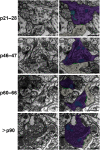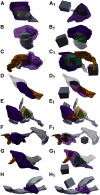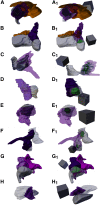Cortical Presynaptic Boutons Progressively Engulf Spinules as They Mature
- PMID: 32958478
- PMCID: PMC7568603
- DOI: 10.1523/ENEURO.0426-19.2020
Cortical Presynaptic Boutons Progressively Engulf Spinules as They Mature
Abstract
Despite decades of discussion in the neuroanatomical literature, the role of the synaptic "spinule" in synaptic development and function remains elusive. Canonically, spinules are finger-like projections that emerge from postsynaptic spines and can become enveloped by presynaptic boutons. When a presynaptic bouton encapsulates a spinule in this manner, the membrane apposition between the spinule and surrounding bouton can be significantly larger than the membrane interface at the synaptic active zone. Hence, spinules may represent a mechanism for extrasynaptic neuronal communication and/or may function as structural "anchors" that increase the stability of cortical synapses. Yet despite their potential to impact synaptic function, we have little information on the percentages of developing and adult cortical bouton populations that contain spinules, the percentages of these cortical spinule-bearing boutons (SBBs) that contain spinules from distinct neuronal/glial origins, or whether the onset of activity or cortical plasticity are correlated with increased prevalence of cortical SBBs. Here, we employed 2D and 3D electron microscopy to determine the prevalence of spinules in excitatory presynaptic boutons at key developmental time points in the primary visual cortex (V1) of female and male ferrets. We find that the prevalence of SBBs in V1 increases across postnatal development, such that ∼25% of excitatory boutons in late adolescent ferret V1 contain spinules. In addition, we find that a majority of spinules within SBBs at later developmental time points emerge from postsynaptic spines and adjacent boutons/axons, suggesting that synaptic spinules may enhance synaptic stability and allow for axo-axonal communication in mature sensory cortex.
Keywords: critical period; developmental plasticity; electron microscopy; focused ion beam scanning electron microscopy; presynaptic terminal; synaptic plasticity.
Copyright © 2020 Campbell et al.
Figures








Similar articles
-
Dendritic spinule-mediated structural synaptic plasticity: Implications for development, aging, and psychiatric disease.Front Mol Neurosci. 2023 Jan 20;16:1059730. doi: 10.3389/fnmol.2023.1059730. eCollection 2023. Front Mol Neurosci. 2023. PMID: 36741924 Free PMC article. Review.
-
Synaptic spinules are reliable indicators of excitatory presynaptic bouton size and strength and are ubiquitous components of excitatory synapses in CA1 hippocampus.Front Synaptic Neurosci. 2022 Aug 11;14:968404. doi: 10.3389/fnsyn.2022.968404. eCollection 2022. Front Synaptic Neurosci. 2022. PMID: 36032419 Free PMC article.
-
Critical assessment of the involvement of perforations, spinules, and spine branching in hippocampal synapse formation.J Comp Neurol. 1998 Aug 24;398(2):225-40. J Comp Neurol. 1998. PMID: 9700568
-
Trans-endocytosis via spinules in adult rat hippocampus.J Neurosci. 2004 Apr 28;24(17):4233-41. doi: 10.1523/JNEUROSCI.0287-04.2004. J Neurosci. 2004. PMID: 15115819 Free PMC article.
-
Structure, Distribution, and Function of Neuronal/Synaptic Spinules and Related Invaginating Projections.Neuromolecular Med. 2015 Sep;17(3):211-40. doi: 10.1007/s12017-015-8358-6. Epub 2015 May 26. Neuromolecular Med. 2015. PMID: 26007200 Free PMC article. Review.
Cited by
-
Dendritic spinule-mediated structural synaptic plasticity: Implications for development, aging, and psychiatric disease.Front Mol Neurosci. 2023 Jan 20;16:1059730. doi: 10.3389/fnmol.2023.1059730. eCollection 2023. Front Mol Neurosci. 2023. PMID: 36741924 Free PMC article. Review.
-
Distribution of spine classes shows intra-neuronal dendritic heterogeneity in mouse cortex.Neurophotonics. 2025 Jan;12(1):015001. doi: 10.1117/1.NPh.12.1.015001. Epub 2024 Dec 19. Neurophotonics. 2025. PMID: 39712647 Free PMC article.
-
Volume electron microscopy reveals 3D synaptic nanoarchitecture in postmortem human prefrontal cortex.iScience. 2025 May 26;28(7):112747. doi: 10.1016/j.isci.2025.112747. eCollection 2025 Jul 18. iScience. 2025. PMID: 40585366 Free PMC article.
-
Invaginating Structures in Synapses - Perspective.Front Synaptic Neurosci. 2021 May 24;13:685052. doi: 10.3389/fnsyn.2021.685052. eCollection 2021. Front Synaptic Neurosci. 2021. PMID: 34108873 Free PMC article.
-
Synaptic spinules are reliable indicators of excitatory presynaptic bouton size and strength and are ubiquitous components of excitatory synapses in CA1 hippocampus.Front Synaptic Neurosci. 2022 Aug 11;14:968404. doi: 10.3389/fnsyn.2022.968404. eCollection 2022. Front Synaptic Neurosci. 2022. PMID: 36032419 Free PMC article.
References
MeSH terms
LinkOut - more resources
Full Text Sources
